THE HISTORY OF SHELBOURNE F.C.
Quick Link to:
IN
THE BEGINNING…
|
I |
n 1895, James Rowan and a group
of his associates founded Shelbourne F.C. in Ringsend, Dublin. The club owed
its name to the local Shelbourne Road, on which stood the hostelry, the
Shelbourne House, where a collection was held both to buy the club’s first kit
and to pay for its first affiliation fee. The club initially played its matches
on Havelock Square, which now lies in the shadow of Lansdowne Road Rugby
Ground. However, it soon moved to new grounds on nearby Bath Avenue.
Shelbourne entered
both the Leinster Junior Championship and Cup the following year – winning them
both with an impressive record of 25 wins from 28 matches played, coupled with
a goal difference of +94! The club’s first ever competitive game resulted in a
2-2 draw with Pembroke. This early league and cup double gave Shelbourne entry
to the Leinster Senior League, where, this time, it finished runner-up in both
league and cup. Two seasons later, the club lifted its first senior title with
a 1-0 win over local rivals Freebooters in the Leinster Senior Cup Final - a
title the club would win a further nine times in the next nineteen years.
THE
IFA YEARS
|
G |
iven
its success at provincial level, Shelbourne was invited to join the Irish
League at the start of the 1904/05 season, where it finished a creditable
fifth. The club’s first win in this league was a 3-1 victory over Glentoran in
September 1904. Again, Shelbourne reached the Cup Final in its first season in
a new league, but was defeated 3-0 on the day by Distillery.
In fact, this was the start of an impressive run of four
consecutive Cup Finals. The 1906 final ended in success, as Shelbourne beat
Belfast Celtic 2-0, with James Owens scoring both goals. However, the following
two finals brought disappointment when Cliftonville and Bohemians won 1-0 and
3-1 respectively in replays. In the second final, Shelbourne actually missed
two penalties!
Club captain, Val Harris, played in all four finals. He was also
the first Shelbourne player to be capped for Ireland, when so selected in 1906.
Val went on to play for Everton in the pre-war years before rejoining the Reds
once more after the war.
Also,
in 1906, Shelbourne moved into Freebooters’ ground off Sandymount Road, when
the latter went into decline. This would remain the club’s home until 1913.
Fortunately, Shelbourne did not have to wait long to avenge its
1908 Cup Final defeat, when, in the 1911 final, it beat Bohemians 2-1 in a
replay. Shelbourne would win this Cup one last time in 1920. However, this
success came in an unorthodox manner. The Reds had qualified for the final with
a 3-0 win over Glenavon. However, the other semi-finalists, Glentoran and
Belfast Celtic, were both expelled from the competition, meaning that
Shelbourne won the Cup by virtue of being the only team left in it!
By now, Shelbourne were playing in Shelbourne Park in Ringsend, to
which they had moved in 1913. This ground would be their home for the next 36
years.
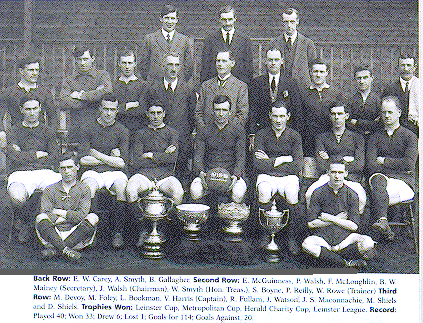 >
>
A NEW LEAGUE
|
B |
y
the start of the 1920s, the political situation in Ireland was adversely
affecting the running of the Irish League. Having played in the 1919/20 season,
following the league's resumption after the First World War, neither Bohemians
nor Shelbourne could participate the following season as the onset of the War
of Independence made travelling too difficult. This situation was then
exacerbated by a row between Shelbourne and the IFA over the latter’s decision
to schedule Shelbourne’s 1921 IFA Cup semi-final replay in Belfast, after the
original game had also been hosted there. The cost of such a journey was
expensive at the time, so Shelbourne felt that it was being asked to shoulder
an unfair financial burden by having to make the same trip twice. The
justifications given by the IFA for its decision were unconvincing and
Shelbourne, with the backing of the Leinster Football Association, withdrew
from the competition in protest.
The
southern clubs ultimately broke away that year to form the Football Association
of Ireland (FAI). For the 1921/22 season, these clubs started a new competition
– the Football League of the Irish Free State, the forbearer of today’s
competition. Including Shelbourne, eight teams founded this league. The others
were Bohemians, Dublin United, Frankfort, Jacobs, Olympia, St. James’ Gate, and
YMCA.
A quiet first season for Shelbourne in this new league was
followed by a second place the following year and a surprise 1-0 defeat in the
FAI Cup Final to Belfast amateur side, Alton United. Shelbourne again missed a
penalty in the game. Further cup final disappointment came in 1925 when
Shelbourne lost 2-1 to Shamrock Rovers. Shelbourne’s goal that day was actually
an own goal by Rovers forward, Billy “Sacky” Glen, who would remarkably create
an important piece of club history over a decade later in 1939.
SUCCESS AFTER
SUCCESS!
|
H |
owever,
Shelbourne’s fortunes changed the following season when it captured its first
league title with a record of 14 wins in 18 games and an average of 3.6 goals
scored per game! The remarkable Val Harris (pictured above, holding the
football) was part of this team and had also played in the 1923 and 1925 Cup
Finals. Indeed, he was a still a player of sufficient stature that he
represented the league twice in 1925 in inter-league matches.
The club had only a short wait before it won a second league title
in 1929. Once more the winning record was impressive, with only one draw and
one defeat in 18 games. Val Harris had hung up his boots by now, but another
famous player, Billy Lacey, who was also in his second spell at the club, was
in the team. Billy was celebrated for having scored twice in Ireland’s 1914 win
over England – the latter’s first defeat by Ireland on home soil. He then went
in goal in the subsequent match against Scotland, after the regular keeper was
injured during the game, and helped the team to a 1-1 draw. These results won
Ireland’s first British Home Championship title. Val Harris also played in
these games.
The club’s run of early titles continued with a third success in
1930/31. This was the season that Alex Hair set the current club record of 29
league goals in a season. This tally was over half of the total scored by the
team that season and came at a rate of 1.3 goals per game.
The club’s run of success hit a rock, however, in the
mid-thirties, when it was suspended from the league following a dispute with
the FAI. The suspension lasted two seasons before being lifted again in 1936.
In the meantime, Shelbourne competed in and won the Dublin-based Athletic Union
League, where it played against St. Patrick’s Athletic for the first time. An
interesting footnote to this low point in the club’s history was that a number
of the club’s players set up another side called Red United that, in 1934/35,
competed in the Leinster Senior League and Cup, as well as the FAI Cup. It then
came fourth in the National League in 1935/36. This side then resigned from the
league to allow for the reinstatement of Shelbourne in 1936.
In 1939, the club won through to the Cup Final for the third time
in its history. This final would be remembered for the contributions of two
Billys – the first being the renowned English goal-scoring ace, Billy “Dixie”
Dean, who had recently joined the other finalists, Sligo Rovers. In the Final,
Dean scored a first-half opener, only for Sammy Smyth to equalise directly from
a corner kick late in the game to force a replay. This game was settled by a
single goal from a free kick by Billy “Sacky” Glen - now a Shelbourne player.
Another link back to that 1925 Cup Final was the Shelbourne team coach in 1939
– the redoubtable Val Harris! Sacky would later coach the team in the forties
when Johnny Feenan was manager.
THE
FORTIES AND FIFTIES
|
T |
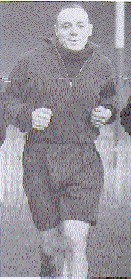 he 1940s saw the
club win two further league titles in 1943/44 and 1946/47 respectively. The
club also lost in two Cup Finals – a 3-2 defeat to Shamrock Rovers in 1944
(once more, Shelbourne missed a penalty!), when the Reds were chasing a league
and cup double, and a hugely disappointing 3-0 defeat to Dundalk in 1949, in a
game that Shelbourne was widely tipped to win. That year, the club also left
Shelbourne Park. In the coming years, it would play in Milltown, Dalymount
Park, Irishtown and Tolka Park.
he 1940s saw the
club win two further league titles in 1943/44 and 1946/47 respectively. The
club also lost in two Cup Finals – a 3-2 defeat to Shamrock Rovers in 1944
(once more, Shelbourne missed a penalty!), when the Reds were chasing a league
and cup double, and a hugely disappointing 3-0 defeat to Dundalk in 1949, in a
game that Shelbourne was widely tipped to win. That year, the club also left
Shelbourne Park. In the coming years, it would play in Milltown, Dalymount
Park, Irishtown and Tolka Park.
In 1951, the club made it three Cup Final defeats on the trot when
losing to Cork Athletic in a replay. However, Tommy Carberry had the
distinction that season of scoring in every round of the Cup, including the
equaliser that sent the final to a replay.
Other players of note from this era included full-back Peter
Keely, who’s son would later manage the team, the Irish international forward,
Gerry Malone, captain Sean Haughey, brother of the former Taoiseach, goalkeeper
Norman Tapkin, who would later manage the club, and another Irish
international, Eddie Gannon (pictured right), who scored an own goal in the
1944 Cup Final and who’s son would create his own piece of club history more
than three decades later.
In 1951/52, Rory Dwyer set the current club record of 40 goals in
a season in all competitions. This came by way of 22 league goals, 2 in the FAI
Cup, 14 more in the League of Ireland Shield, and a final 2 in the Leinster
Senior Cup. However, the season did not fully reflect this personal success, with
Shelbourne finishing runners-up in the league, the League of Ireland Shield,
and the Leinster Senior Cup.
Success did come the following season though, when the club won
its sixth league championship, with a record of 13 wins and 5 draws in 22
games. Rory Dwyer again finished the season as the club’s top scorer, playing
alongside Gerry Malone. Indeed, both forwards are still well placed on the
club’s list of all-time highest league goal-scorers. Gerry is currently in
third place with a tally of 67 goals, while Rory is back in fourth with 59
goals.
During 1956/57, Gerry Doyle, a former Shelbourne player, replaced
Eddie Gannon as manager. Gerry would now mastermind one of the most celebrated
periods in the club’s history, beginning with the 1960 Cup Final win.
DOYLE’S
BOYS
|
E |
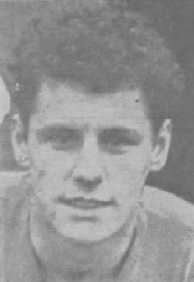 ssentially, Gerry gave youth its chance and it worked marvellously
well. The team in 1960 included Finbarr Flood, the current chairman, in goal, Tony
Dunne, who would sign for Manchester United that summer, in defence, alongside
Freddie Strahan, who would be capped for Ireland, as would Jackie Hennessy,
Theo Dunne, Christy Doyle, and a Shelbourne legend-in-the-making, forward Eric
Barber (pictured right).
ssentially, Gerry gave youth its chance and it worked marvellously
well. The team in 1960 included Finbarr Flood, the current chairman, in goal, Tony
Dunne, who would sign for Manchester United that summer, in defence, alongside
Freddie Strahan, who would be capped for Ireland, as would Jackie Hennessy,
Theo Dunne, Christy Doyle, and a Shelbourne legend-in-the-making, forward Eric
Barber (pictured right).
On the way to the final, Shelbourne had impressively eliminated
Bohemians, Shamrock Rovers, and Dundalk, scoring thirteen goals in four games.
Shelbourne won 2-0 in the final with efforts from Eric Barber and Joey Wilson.
Despite this being the club’s seventh appearance in the Final, it was only its
second success - 21 years after the first one.
In 1961/62, the club was on course to achieve its first league and
cup double, having qualified for the Cup Final and having reached a play-off
for the league title. Sadly, the club’s double ambitions were once more crushed
by Shamrock Rovers, this time a 4-1 defeat in the Cup Final. That Rovers side
boasted the mighty Paddy Ambrose, who scored twice in the game. Fortunately,
the disappointment only lasted a week, however, because Shelbourne returned to
Dalymount Park to face Cork Celtic in the league play-off. Ben Hannigan scored
to give the Reds a 1-0 win and their seventh league championship.
This success entitled Shelbourne to play in Europe for the first
time, where it was drawn against Sporting Club of Lisbon in the Champions’ Cup.
In September 1962, 22,000 people saw Shelbourne go down to a gallant 2-0 defeat
in Dalymount Park, before losing 5-1 in the away leg. Jackie Hennessy had the
honour of scoring the club’s first goal in European competition.
That season ended with a second consecutive Cup Final appearance,
where the two Paddys - Roberts and Bonham respectively - earned the club a 2-0
win over Cork Hibernian.
This success ensured Shelbourne another appearance in Europe where
they were drawn against Barcelona in the Cup-Winners’ Cup. Again, a large home
crowd saw Shelbourne lose 2-0. However, pride was restored in front of 40,000
in the Nou Camp. The part-timers of Shelbourne scored through a Paddy Bonham
penalty in the 30th minute and then held this lead for a long spell despite
being down to 10 men through injury. Unfortunately, the Reds tired towards the
end and Barcelona ran in three late goals to win the tie handsomely.
Shelbourne would play in Europe again the following season. This
time they qualified for the Inter Cities Fairs Cup (later the UEFA Cup). The
first round was a tie against the Portuguese side, Belenenses, also from
Lisbon. Shelbourne earned a 1-1 draw in the away leg, thanks to a late Eric
Barber equaliser, but were then held 0-0 in the home leg. Under the competition
rules at the time, a play-off was required to decide the winner of the tie.
Shelbourne won firstly the toss for home advantage and then its first victory in
European competition, thanks to a 2-1 win with goals from Ben Hennigan and Mick
Conroy. This was only the second time ever that a club from the FAI National
League had advanced to the second round of a European competition and it earned
the Reds a meeting with Atletico Madrid. Despite the difference in class,
Shelbourne acquitted itself well and only went down to two single-goal defeats,
losing 2-0 on aggregate.
Despite no further domestic success in the intervening years,
Shelbourne qualified once more for Europe in 1971, where it faced Vasas of
Hungary in the UEFA Cup. While Shelbourne drew 1-1 at home, a 1-0 defeat in the
prior away leg cost the club the tie. Johnny Murray scored for Shelbourne.
TIME
IN THE DOLDRUMS
|
I |
n 1973, Cork Hibernian gained revenge for its Cup Final defeat a
decade earlier with a 1-0 win in a replay. Another Cup Final defeat followed in
1975, when Home Farm achieved a shock 1-0 victory. Dermot Keely played for Home
Farm that day, but would make part-amends for that sin against his future
employers during the following season.
1975 was a big year of change for the club. At the start of the
1975/76 season, Shelbourne moved into Harold’s Cross Stadium where, after the
first few matches, a major era in the club’s history ended with the resignation
of Gerry Doyle and the appointment of Tommy Conroy, the former Irish
international and Shelbourne defender, as manager.
There were two matches worth noting from that season. The first
was a 3-1 defeat of St. Patrick’s Athletic, where Dermot Keely significantly
improved his chances of later managing the Reds when he mis-hit a clearance,
thus allowing Shelbourne to score a crucial third goal when the score was only
2-1! The second game was a 2-1 victory over Cork Celtic, who had a certain
George Best playing upfront for them. George had signed to play in Celtic’s
home games, but Shelbourne offered to pay his expenses if he lined out in
Dublin against them. This offer was in the hope of improving the gate. While
the idea was a financial success, it also seems to have been tactically quite
astute, as George only went through the motions in the game and ultimately
Shelbourne won the match!
Shelbourne’s worst season to date probably then occurred in
1979/80. It was eliminated in the first round of every Cup competition and
finished bottom of 16 teams in the league. This league campaign saw a record 83
goals conceded, a record 21 games lost, and the club’s worst ever defeat when
Dundalk recorded a humiliating 9-0 victory.
Shelbourne’s manager for part of that season was Eric Barber.
However, he resigned in 1980 and so brought an illustrious career in the red
shirt to an end. Eric’s playing career at the club had spanned an amazing 22
years, during which he scored 126 league and 17 cup goals - the former being a
club record to this day. He also made 222 league appearances and 39 cup
appearances, which is also a club record. On a similar note, around this time,
Mick Gannon also set the current club record of 257 league appearances.
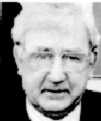 This period offered little encouragement to the small band of
loyal supporters who remained with the club throughout this dismal time. The
club was even relegated in 1986, but bounced straight back up the following season
behind Derry City.
This period offered little encouragement to the small band of
loyal supporters who remained with the club throughout this dismal time. The
club was even relegated in 1986, but bounced straight back up the following season
behind Derry City.
However, from the depths of these dark days emerged the most
remarkable period in the club’s history to date. The catalyst for this change
in fortunes was one Tony Donnelly (pictured right), who acquired the club in
the late eighties and was instrumental in bringing Shelbourne to its current
home of Tolka Park.
A
RENAISSANCE
|
P |
 at Byrne (pictured
right) was appointed manager in 1988. By the 1991/92 season, he had built up
one of the most impressive teams in the club’s history and led Shelbourne to
its eighth league championship, exactly 30 years after their last one. The team
achieved 21 wins in 33 games and scored 57 goals on route to a title that they
eventually won with a 3-1 win over Dundalk at Oriel Park. Garry Haylock
finished the season as top scorer with 13 league goals. Other names from this
great side include Gary Howlett (pictured below left), Bobby Browne, Padraig
Dully, Brian Flood, Mick Neville, and Anto Whelan.
at Byrne (pictured
right) was appointed manager in 1988. By the 1991/92 season, he had built up
one of the most impressive teams in the club’s history and led Shelbourne to
its eighth league championship, exactly 30 years after their last one. The team
achieved 21 wins in 33 games and scored 57 goals on route to a title that they
eventually won with a 3-1 win over Dundalk at Oriel Park. Garry Haylock
finished the season as top scorer with 13 league goals. Other names from this
great side include Gary Howlett (pictured below left), Bobby Browne, Padraig
Dully, Brian Flood, Mick Neville, and Anto Whelan.
Naturally, securing a league championship meant a return to
European competition. Shelbourne drew Tavaria Simferopol, from the south of the
Ukraine, in the preliminary round of the Champions’ Cup. A 0-0 home draw was
followed by a narrow 2-1 defeat in Simferopol, with Padraig Dully scoring for
Shelbourne.
 The 1992/93 season
ended in an amazing three-way tie at the top of the table involving Shelbourne,
Cork City, and Bohemians. Shelbourne had only ensured its place in the
subsequent play-off with a last gasp winner from Paul Doolin in the final game
of the season against Derry City. The teams still finished level after four
play-off matches. However, in a subsequent round of games, Cork City eventually
won the title with victories over both of the other teams.
The 1992/93 season
ended in an amazing three-way tie at the top of the table involving Shelbourne,
Cork City, and Bohemians. Shelbourne had only ensured its place in the
subsequent play-off with a last gasp winner from Paul Doolin in the final game
of the season against Derry City. The teams still finished level after four
play-off matches. However, in a subsequent round of games, Cork City eventually
won the title with victories over both of the other teams.
As happened in 1962 - the last time Shelbourne was involved in a
league play-off - the club also reached the Cup Final, where a Greg Costello
header against Dundalk was enough to secure the cup for only the fourth time in
the club’s history.
The subsequent Cup-Winners’ Cup draw incredibly sent Shelbourne
back to the Ukraine, where they now faced Karpaty Lvov, from the west of the
country. A late goal gave Karpaty a lead to take away with them, but the Reds
were too strong in Tolka Park, winning 3-1 on the night with goals from Greg
Costello, Brian Mooney, and Toni Izzi. This win earned the club a meeting with
the Greek side, Panathinaikos. The Greeks won 3-0 at home and then ensured
their passage through to the next round by winning 2-1 away. Brian Mooney again
scored for Shelbourne.
THE
REVOLVING DOOR
|
O |
ff the field, Shelbourne began a merry-go-round of firing and
hiring managers, starting with the sudden dismissal of Pat Byrne and Jim McLaughlin.
Jim had masterminded many league and cup successes in the seventies and
eighties for Dundalk, Shamrock Rovers, and Derry City and his appointment to
work alongside Pat Byrne had been a key factor behind the club’s 1992 league
triumph.
 The former Irish
international manager, Eoin Hand was their replacement. Hand only lasted until
January 1994 with Eamonn Gregg then taking over as his successor. Gregg’s reign
was just as ill fated and, by November of that year, he too had left. Colin
Murphy then took over at the helm, where he succeeded in guiding the club to
the 1995 Cup Final, but Shelbourne lost 2-1 to Derry City on the day.
The former Irish
international manager, Eoin Hand was their replacement. Hand only lasted until
January 1994 with Eamonn Gregg then taking over as his successor. Gregg’s reign
was just as ill fated and, by November of that year, he too had left. Colin
Murphy then took over at the helm, where he succeeded in guiding the club to
the 1995 Cup Final, but Shelbourne lost 2-1 to Derry City on the day.
Murphy resigned that summer to take up another offer, so
Shelbourne had to entice Damien Richardson (pictured below right), a former
Shamrock Rovers player, out of managerial retirement to be the club’s next
manager. Fortunately, the club had at last found a man who would bring some
much needed stability to the club, while recapturing some of the success and
excitement that had been the hallmark of Pat Byrne’s time in charge.
RICO’S
ROLLERCOASTER RIDE
|
T |
 he
1995/96 season began with a UEFA Cup tie against Icelandic side, Akranes, which
Shelbourne lost 6-0 on aggregate. However, success was soon at hand when the
club beat Sligo Rovers in the final of the League Cup. Rovers had won its home
leg 1-0, but Shelbourne recovered to win 2-1 in Tolka Park and eventually took
the cup on penalty kicks. Brothers, Declan and Stephen Geoghegan (pictured
below right) were the club’s goal scorers in the second leg.
he
1995/96 season began with a UEFA Cup tie against Icelandic side, Akranes, which
Shelbourne lost 6-0 on aggregate. However, success was soon at hand when the
club beat Sligo Rovers in the final of the League Cup. Rovers had won its home
leg 1-0, but Shelbourne recovered to win 2-1 in Tolka Park and eventually took
the cup on penalty kicks. Brothers, Declan and Stephen Geoghegan (pictured
below right) were the club’s goal scorers in the second leg.
At the end of the season, the club faced St. Patrick’s Athletic in
what proved to be possibly the most thrilling Cup Final in the competition’s
history. Pats had already won the league, which meant that both sides were
trying to achieve a “double”. In the match, goalkeeper Alan Gough was sent off
for Shelbourne and Brian Flood, an outfield player, had to replace him in goal.
Although Pats eventually took the lead, Tony Sheridan earned Shelbourne a
replay with an amazing equalising strike. The replay was even more dramatic.
Pats once more took the lead through Dave Campbell, only for Tony Sheridan to
once more square it up for Shelbourne. Then, with only ten minutes remaining,
Pats were awarded a penalty kick that Alan Gough brilliantly saved. The Reds
broke from the following corner and Mark Rutherford crossed for Stephen
Geoghegan to lob home a dramatic winner.
Europe proved once more to be a disappointment, though, with
Shelbourne losing 3-1 at home and 2-1 away to the Norwegian side, SK Brann, in
the Cup-Winners’ Cup. Stephen Geoghegan and Mark Rutherford, respectively,
scored the goals for the Reds.
Shelbourne maintained its remarkable run of Cup Final appearances
by reaching it again in 1997. The opponents once more were Derry City, who had
won just won the league. However, goals from Dave Campbell, now a Shelbourne
player, and Stephen Geoghegan ensured a successful defence of the Cup.
The 1997/98 season was one of the most fascinating in the club’s
history, yet one of its cruellest. It began with another Cup-Winners’ Cup tie –
this time against Kilmarnock of Scotland. Despite losing to another late away
goal, a Mark Rutherford strike meant Shelbourne just needed to win 1-0 at home
to take the tie. It was not to be, however, as Kilmarnock got a 1-1 draw and a
place in the next round. Dessie Baker scored this time for Shelbourne.
The Reds then reached another League Cup Final against Sligo Rovers.
The sense of déjà-vu was increased when Rovers once more took a 1-0 lead to
Tolka Park. However, that was as far as history was prepared to repeat itself,
as Rovers earned the 0-0 draw they needed to win the Cup.
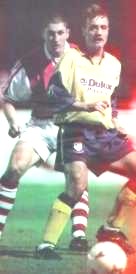 The rest of the season was all about Shelbourne and St. Patrick’s
Athletic. Vying with each other in the league, they were also drawn together in
the Cup quarter-finals. Even after two replays and a league fixture in-between,
the sides could not be separated. So the epic battle had to be decided on
penalty kicks, which saw Shelbourne emerge as winners and later go on to reach
its fourth consecutive Cup Final.
The rest of the season was all about Shelbourne and St. Patrick’s
Athletic. Vying with each other in the league, they were also drawn together in
the Cup quarter-finals. Even after two replays and a league fixture in-between,
the sides could not be separated. So the epic battle had to be decided on
penalty kicks, which saw Shelbourne emerge as winners and later go on to reach
its fourth consecutive Cup Final.
The league battle between these two heavyweights also went the
distance, with Shelbourne guaranteed the title if it won on the last day
against Dundalk. However, the Reds lost 2-1, while Pats won its fixture and
therefore the league.
Shelbourne still had the Cup Final to make amends in, but the
team’s self-belief was gone and Cork City eventually won 1-0 in a replay.
The bitter disappointment of not winning the league led to Damien
Richardson’s decision that summer to resign. The board then decided to appoint
Dermot Keely in July 1998 to succeed him.
VIVALDI'S
FOUR SEASONS
|
S |
 helbourne drew Glasgow Rangers in the UEFA Cup that autumn.
Following security advice, it was decided to play Shelbourne’s ‘home’ game in
Fratton Park in Liverpool. The Reds went into an amazing 3-0 lead thanks to an own
goal and two further strikes from Mark Rutherford and Pat Morley. However, like
their predecessors in 1963, Shelbourne could not hold out and the Scottish team
eventually won 5-3, before taking the second leg 2-0 in Ibrox.
helbourne drew Glasgow Rangers in the UEFA Cup that autumn.
Following security advice, it was decided to play Shelbourne’s ‘home’ game in
Fratton Park in Liverpool. The Reds went into an amazing 3-0 lead thanks to an own
goal and two further strikes from Mark Rutherford and Pat Morley. However, like
their predecessors in 1963, Shelbourne could not hold out and the Scottish team
eventually won 5-3, before taking the second leg 2-0 in Ibrox.
Despite a quiet subsequent season that saw a re-blooding of the
club, Shelbourne still qualified for the Inter-Toto Cup, where it faced the
Swiss side, Neuchatel Xamax. A 0-0 home draw was followed by a 2-0 away defeat,
which saw Shelbourne out of Europe once more.
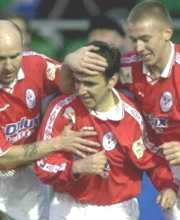 However, 1999/00 was ultimately a great season for the club. The
Reds went unbeaten in their first 20 league games of the season, before
comfortably securing a ninth league title for the loss of only two games in
thirty-three. Important players that season included goalkeeper, Steven
Williams, defenders Pat Scully, Tony McCarthy, Owen Heary, and Declan
Geoghegan, midfielders Pat Fenlon (pictured right) and Richie Baker, and
centre-forward Stephen Geoghegan, who top-scored with 11 goals.
However, 1999/00 was ultimately a great season for the club. The
Reds went unbeaten in their first 20 league games of the season, before
comfortably securing a ninth league title for the loss of only two games in
thirty-three. Important players that season included goalkeeper, Steven
Williams, defenders Pat Scully, Tony McCarthy, Owen Heary, and Declan
Geoghegan, midfielders Pat Fenlon (pictured right) and Richie Baker, and
centre-forward Stephen Geoghegan, who top-scored with 11 goals.
The club also completed its first-ever FAI league and cup double,
with a 1-0 defeat of Bohemians in a replay. Pat Fenlon fittingly scored the
winner, after being the club’s most influential player that season.
That summer, Shelbourne won its first ever ‘away’ match in Europe
with a 1-0 defeat of Macedonian side, Sloga Jugomagnat. The goal came from a
free kick by Richie Baker. Garry Haylock, back once more at the club, then
equalised in the home leg, after Sloga had taken the lead. This earned the club
a 2-1 win on aggregate and a meeting with Rosenborg of Norway in the second
preliminary round of the Champions League. A battling performance in the home
leg still saw Shelbourne lose 3-1, before recovering to earn a 1-1 draw in the
away game. Richie Foran scored both of the Reds’ goals.
As in 1998, Shelbourne then went into the last day of the 2000/01
league season with the possibility of winning the title in its own hands. Once
more, though, it was not to be, as a 1-0 defeat at home to Cork City gifted the
title to Bohemians.
Shelbourne played in the UEFA Cup, at the start of the 2001/02
season, against Danish side, Brondby. However, the club was soundly beaten 5-0
on aggregate. Midseason the Donnelly family ended its direct interest in the
club, with ownership passing over to Ollie Byrne, who’s family has been an
integral part of the running of the club for decades.
Shelbourne ended the season with its tenth league championsip,
accumulating 19 wins and 63 points from 33 matches. However, it was a bittersweet
triumph because it was won due to St. Patrick's Athletic being deducted points
for infringing league rules. The matter was compounded by the decision of
Dermot Keely to resign as he had not succeeded in winning the title on the
pitch for the second season in succession.
TODAY
|
P |
at Fenlon quickly emerged as the favourite to succeed Dermot Keely
and was appointed player-manager soon afterwards. Sadly his reign got off to a disappointing
start last season with back-to-back exits in injury time from both Europe,
where Shelbourne lost to Hibernians of Malta in the Champions’ League, and the
FAI Cup, where old foes St. Patrick’s Athletic were victorious. After this, the
club’s fortunes improved and it ended the season well enough to finish a
creditable second in the league, thus earning yet another opportunity to play
in Europe. Come back soon to see how the club fares!
An acknowledgement from the author:
This account of the
club’s history would not have been possible without the research of others. In
particular, articles written by Christopher Sands, Sean Ryan, and Frank Martin
proved an invaluable source of information. I am grateful for it all.
